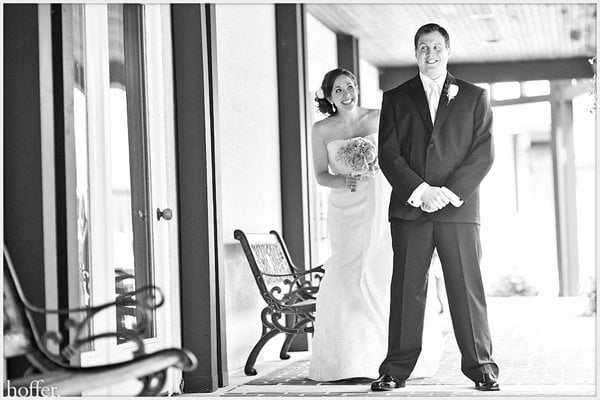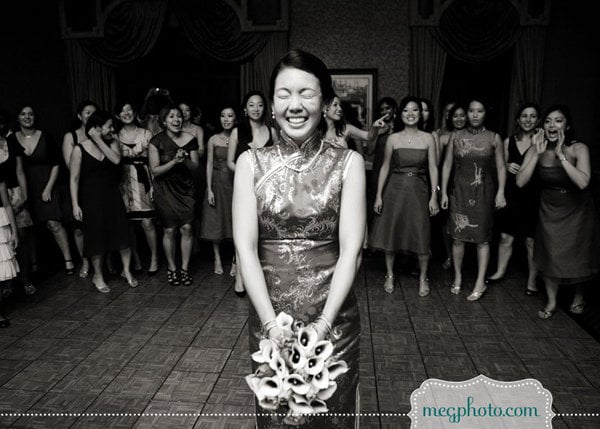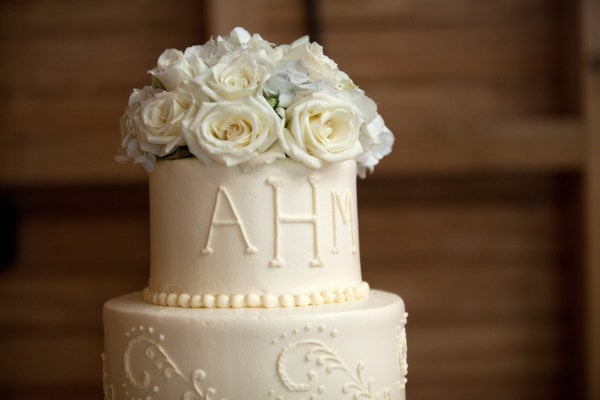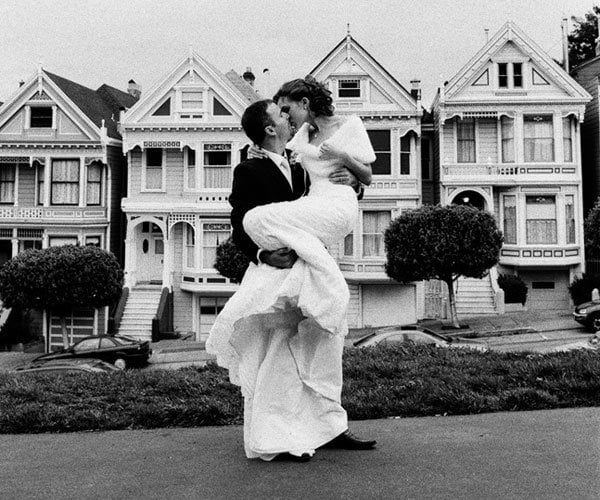why does the groom go under the bride's dress
Some wedding traditions and superstitions are so engrained in our culture that we don't even think to question them. But do you know why a bride tosses the bouquet over her head? For what possible reason would a couple save a layer of cake in their freezer for a year? And why do brides go to such lengths to keep their grooms from seeing their dresses before it's time to walk down the aisle? Here, we explore the origins of five wedding superstitions and help you find ways to incorporate tradition into your special day along with a few fun, modern twists.
Superstition #1: It's bad luck for the groom to see the bride in her wedding dress before the ceremony.

Photo Credit: Hoffer Photography
Origin: During the time when arranged marriages were custom, the betrothed couple wasn't allowed to see each other before the wedding at all. The wedding symbolized a business deal between two families (romantic, huh?), and a father would have been pleased for his daughter to marry a man from a rich, land-owning family. But he also feared that if the groom met the bride before the wedding and thought she wasn't attractive, he'd call off the wedding, casting shame onto the bride and her family. Therefore, it became tradition that the bride and groom were only allowed to meet at the wedding ceremony so that the groom did not have the opportunity to change his mind. And that veil the bride wears? Its original purpose was also to keep the groom from finding out what the bride looked like until the last possible minute, when it was too late to back out of the transaction.
Today: Although arranged marriages are no longer common, most brides still don't want their groom to see them all done up before the wedding. Many believe it makes the day more exciting and memorable. However, some couples feel they'll be more relaxed if they see each other for just a few minutes before the ceremony. The added bonus is that you can take your formal pictures pre-ceremony when everyone is freshly done-up. It's completely up to you and your groom. Talk about it before the big day arrives and find out what makes the most sense for you.
Superstition #2: The bride must wear something old, something new, something borrowed and something blue (and a silver sixpence in her shoe).
Photo Credit: Hoffer Photography
Origin: This Victorian rhyme is a time-honored tradition that is supposed to bring the bride good luck. Wearing "something old" expresses the newlywed couple's desire to retain connections with their family once they enter into married life. One tradition suggests that the bride's "something old" be an old garter given to the bride by a happily married woman so that the new bride would also enjoy a happy marriage. Wearing "something new" conveys that the couple is creating a new union that will endure forever and looking to the future for health, happiness and success. "Something borrowed" is an opportunity for the bride's friends or family to lend her something special as a token of their love. And finally, "something blue" is a symbol of fidelity and constancy. This custom began in ancient Israel, where brides wore a blue ribbon in their hair to symbolize this promise to their new husbands. What you may not realize is that the rhyme actually ends with "…and a silver sixpence in her shoe." Story says that placing a penny in the bride's shoe will bring her a life filled with good fortune.
Today: Many modern brides find it fun to keep with tradition by wearing something old, something new, something borrowed and something blue. Think of creative ways to incorporate all four items into your wedding-day ensemble. For example, Kate Middleton's "something old" wasn't a handkerchief or locket but rather her Alexander McQueen bridal gown, which featured "traditional Carrickmacross craftsmanship," a lace technique dating back to the 1800s.
Superstition #3: The person who catches the bride's bouquet or garter when she tosses it over her head will be the next to get married.

Photo Credit: Meg Baisen Photography
Origin: The story behind this tradition is downright dirty. In medieval times, it was considered lucky to get a fragment of the bride's clothing, so hordes of guests would follow the newlywed couple into their wedding chamber after the ceremony and stand around the bed, trying to rip pieces of the bride's gown right off her body. Because dresses were often torn apart, brides searched for alternatives to preserve their gowns and began throwing their bouquets to distract guests while they made their getaway. When the bride and groom made it safely into their wedding chamber, the groom would then crack open the door and toss the bride's garter to the throngs of people waiting outside as a way of saying that he was about to "seal the deal."
Today: At many modern weddings, the groom removes and tosses the bride's garter to the groomsmen right after the bride tosses her bouquet to the bridesmaids. Traditionally, the unmarried man who catches the garter must place it on the leg of the unmarried woman who catches the bouquet, and it is said that they will be the next two to marry (not necessarily to each other). It's a fun ritual, but many couples have chosen not to include it because guests could be injured easily, and it might embarrass the single women who are "dragged" to the floor to participate. If you have doubts about including this tradition in your wedding, consider an anniversary dance instead, which honors the longest-married couple by presenting them with the bouquet. How it works: Ask your married couples to join you on the dance floor as a slow song plays. Throughout the song, your DJ or bandleader will ask guests to sit down as their length of marriage is called out.
Superstition #4: The bride and groom must save the top layer of their wedding cake to eat on their first anniversary.

Photo Credit: Long's Photography
Origin: To understand this tradition, you just have to think back to a familiar schoolyard rhyme: "First comes love, then comes marriage, then comes the baby in the baby carriage!" It used to be thought that once a wedding took place, a baby was going to come shortly after, so therefore the wedding and christening ceremonies were often linked, as were the respective cakes that were baked for each occasion. With fancy, elaborate, multi-tiered wedding cakes becoming a major trend in the 19th century, the christening cake began to take a back seat to the wedding cake. Since the top tier of the wedding cake was almost always left over, couples began to see the christening as the perfect opportunity to finish the cake. Couples could then logically rationalize the need for three tiers — the bottom for the reception, the middle for distributing, and the top for the christening.
Today: As the time between weddings and christenings widened, the two events became disassociated and the reason for saving the top tier changed. Now, couples enjoy saving the top layer of their wedding cake to eat on their first anniversary as a pleasant reminder of their special day. Sound icky to you? Because the cake does sometimes lose its flavor from being stuck in the freezer for so long, many couples opt to have the baker recreate the top of their wedding cake for their anniversary.
Superstition #5: The groom must carry his new wife across the threshold of their new home to prevent bad luck.

Photo Credit: Tanya Lippert Photography
Origin: This tradition has a few origins. In Medieval Europe, it was scandalous for a woman to show enthusiasm about losing her virginity. By the groom carrying the bride over the threshold, she avoided looking too eager about consummating the marriage. Western Europeans, on the other hand, believed that a bride who tripped over the threshold of her new home would bring bad luck to her home and her marriage. Therefore, the groom carrying the bride into the home was a good way to avoid such a mishap altogether. In ancient cultures, the threshold of the home was considered to be a hotbed of lurking, unattached evil spirits, and since a new bride was particularly vulnerable to spirit intrusion, especially through the soles of her feet, the groom ensured that his wife would not bring any bad spirits into the house by carrying her inside.
Today: The groom carries his bride across the threshold today not because of a fear of spirits, but as a romantic way to welcome her into his life. However, if you consider that each partner is as equal and valuable as the other, why not step over the threshold together?
why does the groom go under the bride's dress
Source: https://www.bridalguide.com/planning/wedding-ceremony-traditions/wedding-superstitions